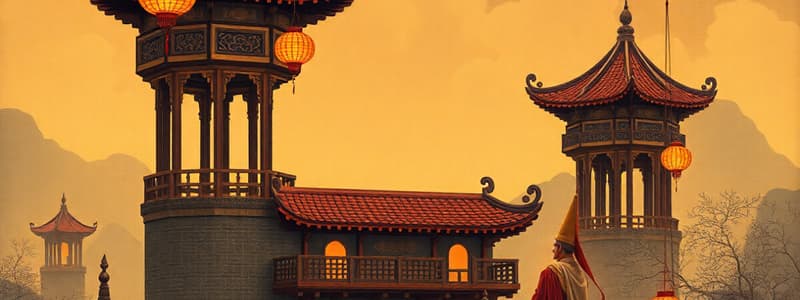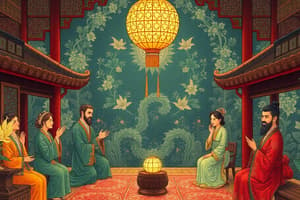Podcast
Questions and Answers
What is the primary focus of Confucianism as a philosophy?
What is the primary focus of Confucianism as a philosophy?
- Religious practices and rituals
- Political ideologies and governance
- Ethics and social harmony (correct)
- Scientific advancement and exploration
Which of the following virtues is associated with respect for parents and elder relatives in Confucianism?
Which of the following virtues is associated with respect for parents and elder relatives in Confucianism?
- Zheng
- Xiao (correct)
- Li
- Ren
How does Confucianism view the relationship between the nation and family?
How does Confucianism view the relationship between the nation and family?
- Nation and family are of equal importance
- Family is prioritized over the nation
- The nation comes before the family (correct)
- Nationhood is an illusion in Confucian thought
What is a key characteristic of the Confucian examination system?
What is a key characteristic of the Confucian examination system?
What does the 'mandate of heaven' signify in Confucian teachings?
What does the 'mandate of heaven' signify in Confucian teachings?
What was the primary currency used in China during the silver-based economy?
What was the primary currency used in China during the silver-based economy?
Which route was significant for transporting silver to China between 1565 and 1815?
Which route was significant for transporting silver to China between 1565 and 1815?
What was a major consequence of the black market for silver in China?
What was a major consequence of the black market for silver in China?
How did the Qing dynasty differ in composition compared to the Ming dynasty?
How did the Qing dynasty differ in composition compared to the Ming dynasty?
What was one of the main goals of the Macartney Mission?
What was one of the main goals of the Macartney Mission?
What was the main reason for the British exporting opium to China?
What was the main reason for the British exporting opium to China?
What was one of the immediate effects of the Opium War on China?
What was one of the immediate effects of the Opium War on China?
What cultural system is said to have prevented innovation in technology within China?
What cultural system is said to have prevented innovation in technology within China?
What significant impact did China's isolation have during the early modern period?
What significant impact did China's isolation have during the early modern period?
Which of the following products was NOT central to China's export during the early modern period?
Which of the following products was NOT central to China's export during the early modern period?
What was a primary characteristic of the society during the Ming Dynasty?
What was a primary characteristic of the society during the Ming Dynasty?
What primarily caused the Mongolian rule in China to lose the 'mandate of heaven'?
What primarily caused the Mongolian rule in China to lose the 'mandate of heaven'?
Which factor contributed to the decline of technology during the Qing Dynasty?
Which factor contributed to the decline of technology during the Qing Dynasty?
What role did the Civil Service Examination serve during the Ming and Qing Dynasties?
What role did the Civil Service Examination serve during the Ming and Qing Dynasties?
How did foreign trade influence the economy during the Ming Dynasty?
How did foreign trade influence the economy during the Ming Dynasty?
What was a significant feature of the Qing Dynasty's military strategy?
What was a significant feature of the Qing Dynasty's military strategy?
What was a notable impact of Confucian values on the social structure in China?
What was a notable impact of Confucian values on the social structure in China?
What resulted from the population increase during the Qing Dynasty?
What resulted from the population increase during the Qing Dynasty?
Which of the following describes the economic state of China during the Yuan Dynasty?
Which of the following describes the economic state of China during the Yuan Dynasty?
What major change occurred under the leadership of Emperor Kangxi?
What major change occurred under the leadership of Emperor Kangxi?
What was a consequence of the maritime trade commission established in the 12th century?
What was a consequence of the maritime trade commission established in the 12th century?
How did women's social status change during the Ming Dynasty?
How did women's social status change during the Ming Dynasty?
What was Zheng He's role in the context of trade during the Ming Dynasty?
What was Zheng He's role in the context of trade during the Ming Dynasty?
Flashcards
What is Confucianism?
What is Confucianism?
Confucianism is a philosophy that emphasizes ethical principles and social harmony, focusing on the importance of relationships, duties, and proper behavior within a hierarchical society.
What is Ren?
What is Ren?
Ren represents the idea of human-heartedness, compassion, and goodness. It encompasses the virtue of loving and caring for all humanity.
What is Xiao?
What is Xiao?
Xiao emphasizes the importance of respecting and honoring one's parents and elders, upholding familial obligations and filial piety. It reflects a fundamental Confucian value.
What was the Confucian exam?
What was the Confucian exam?
Signup and view all the flashcards
What is the Mandate of Heaven?
What is the Mandate of Heaven?
Signup and view all the flashcards
Sycee
Sycee
Signup and view all the flashcards
Manila-Acapulco-Galleon Route
Manila-Acapulco-Galleon Route
Signup and view all the flashcards
Ming Dynasty
Ming Dynasty
Signup and view all the flashcards
Qing Dynasty
Qing Dynasty
Signup and view all the flashcards
Canton System
Canton System
Signup and view all the flashcards
Macartney Mission
Macartney Mission
Signup and view all the flashcards
Opium
Opium
Signup and view all the flashcards
Lin Zexu
Lin Zexu
Signup and view all the flashcards
Opium Wars
Opium Wars
Signup and view all the flashcards
Treaty of Nanjing
Treaty of Nanjing
Signup and view all the flashcards
Confucianism
Confucianism
Signup and view all the flashcards
Mandate of Heaven
Mandate of Heaven
Signup and view all the flashcards
Confucian Exam
Confucian Exam
Signup and view all the flashcards
Mongol Rule (Yuan Dynasty)
Mongol Rule (Yuan Dynasty)
Signup and view all the flashcards
Hongwu Emperor
Hongwu Emperor
Signup and view all the flashcards
Kangxi Emperor
Kangxi Emperor
Signup and view all the flashcards
Zheng He Voyages
Zheng He Voyages
Signup and view all the flashcards
Zheng He's Expeditions
Zheng He's Expeditions
Signup and view all the flashcards
The Silk Road
The Silk Road
Signup and view all the flashcards
Ming Trade
Ming Trade
Signup and view all the flashcards
New World Silver
New World Silver
Signup and view all the flashcards
Ming Decline
Ming Decline
Signup and view all the flashcards
Study Notes
Confucianism in China
- Origins: Confucius, 5th century BCE. Confucian classics include poetry, rituals, and historical traditions.
- Nature: A philosophy, not a religion, focused on ethical and social harmony. Viewed as a civil religion.
- Core Beliefs: Emphasis on family, society, and nation. Education and strong familial relationships. Key virtues include: ren (humanity/love for humanity), li (proper behavior), and xiao (respect for elders).
- Social Structure: A rigid hierarchy with defined roles; emperor (son of heaven), scholar bureaucrats (merit-based), farmers, artisans, merchants.
Economic and Social Development
- Agricultural Society: Stable agrarian society, with taxation and commerce developing after standard measurements. Exported grain, silk, and other goods.
- Maritime Trade: Active maritime trade with Africa, Korea, Japan, and India. Chinese shipbuilding advanced until the 13th century.
- Paper Currency: Introduced in 811.
- Foot Binding: Upper class custom of binding women's feet, viewed as a mark of beauty.
Internal Development and Constraints
- Population Growth: Fast population growth from the 10th century causing strain on the society
- Conservative Bureaucracy: Bureaucracy focused on avoiding change and innovation instead of taking risks and new methods.
Mongol Rule (Yuan Dynasty)
- Foreign Rule: Mongols ruled China (1271-1368), considering Chinese as barbarians.
- Military Society: Shift from an agrarian to a more military society
- Confucian Examination: Abolished during Mongol rule until 1315.
Ming Dynasty
- Han Majority Rule: The Ming Dynasty was established with a focus on a majority Han (ethnic Chinese) society and self-sufficient peasants
- New Tax Sources: Shift from agricultural tax to a silver-based tax system, influenced by the increasing importance of new world silver in world trade
- Ming Decline: Lack of new intellectual breakthroughs, political corruption, and peasant uprisings led to Ming decline and the mandate of heaven
- World Trade: Chinese artisans known for porcelain and silk. China became a dominant importer of new world silver
Qing Dynasty
- Foreign Rule (Manchus): Manchurians (Manchus) were a foreign group who took power in China.
- Expansion of the Empire: Expansionist empire, taking control of Central Asia, Tibet, and Taiwan
- Continued Bureaucracy: The Qing preserved the Confucian examination system, bureaucracy, and Chinese culture
- Kangxi Emperor: Emperor known for merging Manchurian military skills with Chinese administrative expertise. Centralized government, expanded bureaucracy, and passed policies to punish rebellions.
Qing Social and Cultural Patterns
- Traditionalism: Focus on maintaining traditional art, literature, and philosophy.
- Population Growth: Population growth (150 million to 300 million from 1600-1800) driven by new world crops. This created social inequalities.
Qing Decline
- Military Issues: Military declined due to corruption and Manchu generals' focus on personal wealth.
- Pressures From Taxation: Rising tensions and rebellion from taxation issues.
Early Modern Globalization and China
- Zheng He Voyages: Extensive voyages of exploration and trade across the Indian Ocean, Southeast Asia, and east Africa (1405-1433).
- Opium Trade: Introduction and addiction to opium by the British which caused issues and conflict between the two empires
- Canton System: British and Dutch traders restricted to trading in Canton (Guangzhou), limited to five months trading season. Controlled by a Chinese guild (Cohong).
- Macartney Mission: British mission to China to open ports led to a diplomatic failure due to cultural misunderstandings.
- Opium Wars (1839-1842): First Opium War triggered by Chinese attempts to suppress opium trade leading to British military victories.
- Unequal Treaties: Treaties forced upon China by European powers, resulting in lost territories and economic concessions. Westerners gained more control over China
Western influence on China
- 19th Century Relationships: China’s relationships with the West and Japan became increasingly strained, leading to wars and Western dominance over China
- Missionary Activity: Allowed Western missionaries to proselytize and travel freely across China
China's Position in the Global Economy
- Important Trade Partner: China was an important trading partner but later withdrew internally, with emphasis on isolation. Notable products included tea, silk, and porcelain.
Studying That Suits You
Use AI to generate personalized quizzes and flashcards to suit your learning preferences.



